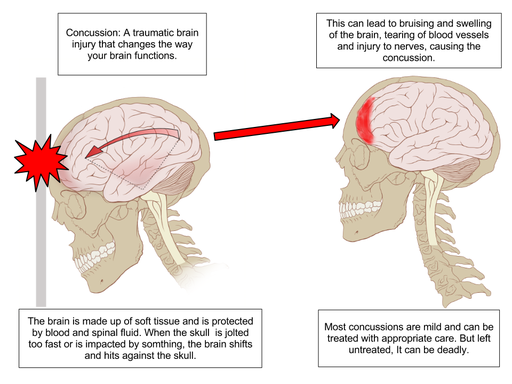According to new research, repeated concussions are linked to worsen brain function in later life, including higher risks of Alzheimers and Parkinson’s disease.
A concussion is a type of traumatic brain injury caused by a bump, blow, or jolt to the head or by a hit to the body that causes the head and brain to move rapidly back and forth. This sudden movement can cause the brain to bounce around or twist in the skull, creating chemical changes in the brain and sometimes stretching and damaging brain cells.
A study led by the University of Oxford and the University of Exeter, published in the Journal of Neurotrauma, included data from over 15,000 participants found that people who reported three or more concussions had significantly worse cognitive function, which got worse with each concussion after that.
The researchers found that reporting even one moderate-to-severe concussion was associated with worsened attention, completion of complex tasks and processing speed capacity. Participants who reported 3 concussions, even mild concussions, throughout their lives had significantly worse attention and ability to complete complex tasks. Those who reported 4 or more mild concussions showed worsened processing speed and working memory. Each additional reported concussion was linked to progressively worse cognitive function.
According to Dr. Vanessa Raymont, senior author of the study from the University of Oxford, head injuries are a major risk factor for dementia and “this large-scale study gives the greatest detail to date on a stark finding — the more times you injure your brain in life, the worse your brain function could be as you age.”
The research indicates that people who have experienced three or more even mild episodes of concussion should be counselled on whether to continue high-risk activities.
This article relates to AP biology because when a concussion occurs this affects the body’s ability to send signal to the brain (cell signaling). Cell signaling occurs when a cell detects a signaling molecule from the outside of the cell. A signal is detected when the chemical signal (also known as a ligand) binds to a receptor protein on the surface of the cell or inside the cell. When the signaling molecule binds the receptor it changes the receptor protein in some way. This change initiates the process of transduction. Signal transduction is usually a pathway of several steps. Each relay molecule in the signal transduction pathway changes the next molecule in the pathway. Finally, the signal triggers a specific cellular response. In cell signaling the axon sends electrical impulses from the neuron travel away to be received by other neurons. After a concussion, damage to axons is much more common than damage to other parts of the cell. The axon in the brain is a long extension of the cell which transmits impulses. The axon carries electrical impulses that help communicate within the brain and between the brain. When the axon is damaged neurons cannot properly communicate, a damaged axon has more trouble sending its signals, interfering with the brain’s ability to do its job. A concussion also makes it difficult for the cells to distribute chemicals and materials to all areas of the cell, this occurs in the synapse where impulses are transmitted from one neuron to another.



Leave a Reply